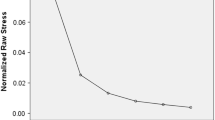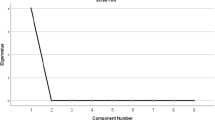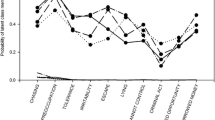Abstract
One of the earliest instruments to screen for problem gambling, the Twenty Questions (20Q), was developed within Gamblers Anonymous. This instrument has not received serious research attention, however, and its psychometric properties are generally unknown. This study reports reliability and validity data for this instrument in 3 independent samples totaling 456 participants: two samples of problem gamblers in treatment and a non-treatment sample of problem gamblers. The Twenty Questions was shown to possess high reliability as measured by Cronbach’s alpha. Concurrent, convergent and predictive validity of the 20Q supported the use of this instrument as an acceptable screening instrument. Classification analyses indicated that the 20Q is comparable to the DSM-IV diagnostic criteria for pathological gambling in specificity, sensitivity and rates of false negatives and false positives. The 20Q appears to be a reliable and valid measure of problem gambling and warrants continued research attention.
Similar content being viewed by others
References
Abell, N. (1991). The index of clinical stress: A brief measure of subjective stress for research and practice. Social Work Research and Abstracts, 27, 12–15.
American Psychiatric Association (1994). Committee on nomenclature and statistics. Diagnostic and statistical manual of mental disorders (4th ed.). Washington, DC: American Psychiatric Association.
Bernstein, E. M., & Putnam, F. W. (1986). Development, reliability and validity of a dissociation scale. Journal of Nervous and Mental Disease, 174, 727–735.
Cox, B. J., Enns, M. W., & Michaud, V. (2004). Comparisons between the South Oaks Gambling Screen and a DSM-IV-based interview in a community survey of problem gambling. Canadian Journal of Psychiatry, 49, 258–264.
Derevensky, J., & Gupta, R. (1997). Prevalence estimates of adolescent gambling: A comparison of the SOGS-RA, DSM-IV-J, and the G.A. 20 Questions. Paper presented at the 10th International Conference on Gambling and Risk-taking, Montreal.
Derogatis, L. R. (1993). The Brief Symptom Inventory (BSI): Administration, scoring and procedures manual (3rd ed.). Minneapolis, MN: National Computer Systems.
Famer, R., & Sundberg, N. (1986). Boredom proneness—the development and correlates of a new scale. Journal of Personality Assessment, 50, 4–17.
First, M. B., Spitzer, R. L., Gibbon, M., & Williams, J. B. W. (2002). Structured Clinical Interview for DSM-IV-TR Axis I Disorders, Research Version, Patient Edition. (SCID-I/P). New York: Biometrics Research, New York State Psychiatric Institute.
Gamblers Anonymous, (1984). (3rd ed.). Los Angeles, CA: Gamblers Anonymous Publishing.
Hardoon, K., Derevensky, J., & Gupta, R. (2003). Empirical measures vs. perceived gambling severity among youth: Why adolescent problem gamblers fail to seek treatment. Addictive Behaviors, 28, 933–946.
Hendrick, S. (1988). A generic measure of relationship satisfaction. Journal of Marriage and the Family, 50, 93–98.
Kuley, N. B., & Jacobs, D. F. (1988). The relationship between dissociative-like experiences and Sensation-seeking among social and problem gamblers. Journal of Gambling Behavior, 4, 197–207.
Lesieur, H., & Blume, S. (1987). The South Oaks Gambling Screen (SOGS): A new instrument for the identification of problem gamblers. American Journal of Psychiatry, 144, 1184–1188.
Littman-Sharpe, N., Turner, N., Toneatto, T., Stripe, T., & Liu, E. (2007). The Inventory of Gambling Situations. Toronto: CAMH. Available online at www.problemgambling.ca.
Neighbors, C., Lostutter, T. W., Larimer, M. E., & Takushi, R. Y. (2002). Measuring gambling outcomes among college students. Journal of Gambling Studies, 18, 339–360.
Petry, N. (2005). Pathological gambling: Etiology, comorbidity and treatment. Washington: American Psychological Association.
Shaffer, H. J., Hall, M. N., & Vander Bilt, J. (1997). Estimating prevalence of disordered gambling behavior in the United States and Canada: A meta-analysis. Boston: Harvard Medical School Division on Addictions.
Stinchfield, R. (2002). Reliability, validity and classification accuracy of the South Oaks Gambling Screen. Addictive Behaviors, 27, 1–19.
Stinchfield, R. (2003). Reliability, validity and classification accuracy of a measure of DSM-IV diagnostic criteria for pathological gambling. American Journal of Psychiatry, 160, 180–182.
Toneatto, T. (1999). The gambling cognition questionnaire. Paper presented at the annual meeting of the American Psychological Association, Boston.
Toneatto, T. (2003a). Cognitive distortions in pathological gambling. Poster presented at the 29th Annual Harvey Stancer Research Day, University of Toronto.
Toneatto, T. (2003b). Male and female pathological gamblers: Similarities and differences. Poster presented at the 29th Annual Harvey Stancer Research Day, University of Toronto.
Ursua, M. P., & Uribelarrea, L. L. (1998). 20 questions of gamblers anonymous: A psychometric study with population of Spain. Journal of Gambling Studies, 14, 3–15.
Vodanovich, S. J., & Kass, S. J. (1990). A factor analytic study of the Boredom Proneness scale. Journal of Personality Assessment, 55, 115–123.
Author information
Authors and Affiliations
Corresponding author
Rights and permissions
About this article
Cite this article
Toneatto, T. Reliability and Validity of the Gamblers Anonymous Twenty Questions. J Psychopathol Behav Assess 30, 71–78 (2008). https://doi.org/10.1007/s10862-007-9070-0
Published:
Issue Date:
DOI: https://doi.org/10.1007/s10862-007-9070-0




